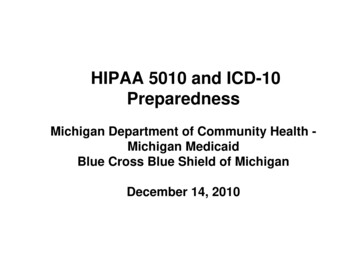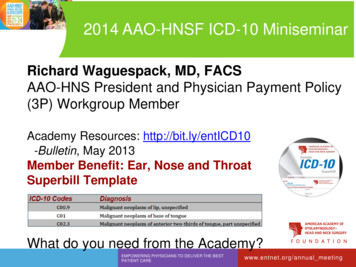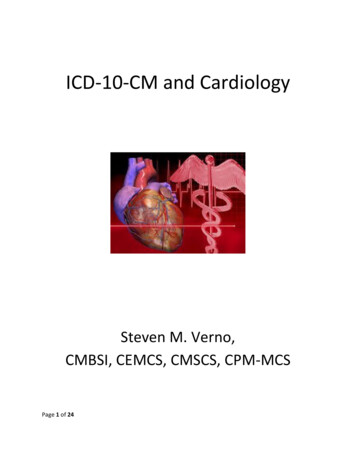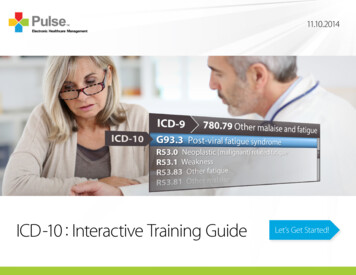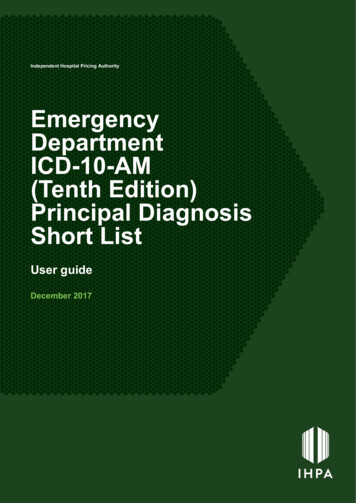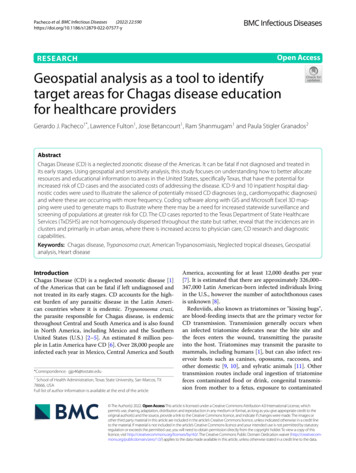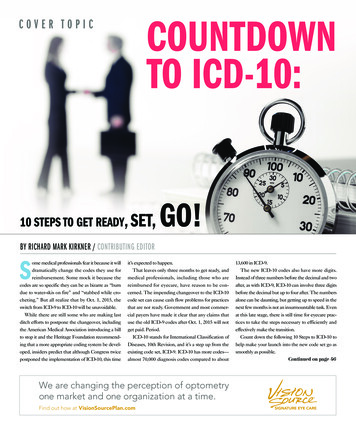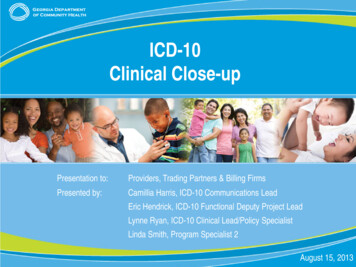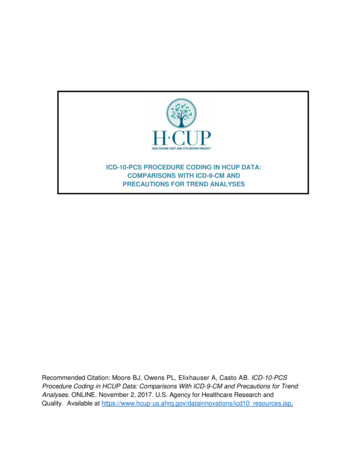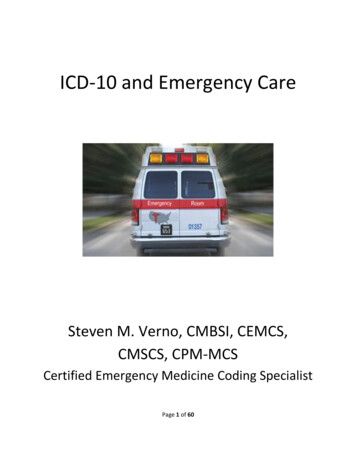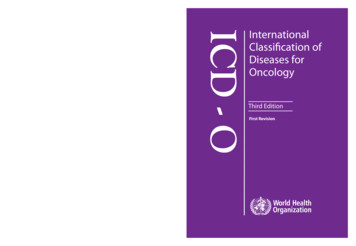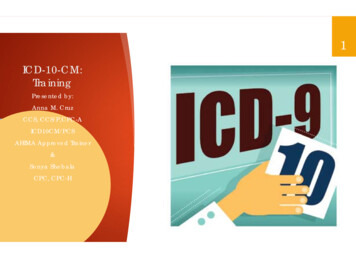
Transcription
1ICD-10-CM:TrainingPresented by:Anna M. CruzCCS, CCS/P,CPC-AICD10CM/PCSAHIMA Approved Trainer&Sonya ShebalaCPC, CPC-H
Partial Freeze of Revisions to ICD-9-CM and ICD-10-CM/PCSCDC.govXOctober 1, 2011 is the last major update of ICD-9-CM. Any further revisions to ICD-9-CM will onlybe for a new disease and/or a procedure representing new technology. Revisions will be postedon this website as addenda (revisions to procedures are posted on the CMS website).XAfter October 1, 2011 there will be no further release of ICD-9-CM on CD-ROM.XOctober 1, 2011 is the last major update of ICD-10-CM/PCS until October 1, 2015.XBetween October 1, 2011 and October 1, 2015 revisions to ICD-10-CM/PCS will be for newdiseases/new technology procedures, and any minor revisions to correct reported errors in theseclassifications.XRegular (at least annual) updates to ICD-10-CM/PCS will resume on October 1, 2015.XICD-10-CM/PCS, on CD-ROM will be released one year prior to implementation.XNote: The 2013 release of the ICD-10-CM is now available. It replaces the December 2011 release.XICD-10-CM 2013 Official Guidelines for Coding and Reporting are also available.2
3Structure and Format of ICD-10-CMXConsists of three to seven charactersXFirst character used is alphaXAll letters used except UXCharacter 2 always numericXCharacters 3 through 7 can be alpha ornumericXDecimal placed after the first threecharactersXAlpha characters are not case-sensitiveX1.A.4. Placeholder characterXXThe ICD-10-CM utilizes a placeholdercharacter “x”. The “x” is used as aplaceholder at certain codes to allow forfuture expansion. An example of this is at thepoisoning, adverse effect and under dosingcodes, categories T36-T50.1.A.5. 7th CharactersXCertain ICD-10-CM categories haveapplicable 7th characters. The applicable7th character is required for all codes withinthe category, or as the notes in the TabularList instruct. The 7th character must alwaysbe the 7th character in the data field. If acode that requires a 7th character is not 6characters, a placeholder X must be used tofill in the empty characters
4Code structure of ICD-10-CM versus ICD-9-CMICD-10-CM codes may consist of up to seven characters, with the seventh characterrepresenting visit encounter or sequelae for injuries and external causes.ICD-9-CM Code FormatCategoryEtiology,anatomic site,manifestationICD-10-CM Code FormatCategoryEtiology,anatomic site,manifestationextension
5MAPPINGXAs a part of the conversion, two sets of diagnosis code GeneralEquivalence Mappings (GEMS) have been developed. Thismapping is a type of crosswalk to find corresponding diagnosiscodes between the two code sets. The GEMs files are:X1. I-9 to I-10, which is forward mappingX2. I-10 to I-9 which is backward mapping
6ICD-10-CM compared to ICD-9-CMXExpanded detail for many conditions (e.g., viral hepatitis has beenexpanded from ICD-9 070, a single 3-digit category, to ICD-10 B15B19, five 3-digit categories.XTransferred conditions around the classification (e.g., hemorrhagehas been moved from the circulatory chapter to the symptomsand signs chapter)
Excludes NotesThe ICD-10-CM has two types of excludes notes. Each type of notehas a different definition for use but they are all similar in that theyindicate that codes excluded from each other are independent ofeach other.a.Excludes1A type 1 Excludes note is a pure excludes note. It means “NOT CODED HERE!” An Excludes1 noteindicates that the code excluded should never be used at the same time as the code above theExcludes1 note. An Excludes1 is used when two conditions cannot occur together, such as acongenital form versus an acquired form of the same condition.b. Excludes2A type 2 Excludes note represents “Not included here”. An excludes 2 note indicates that thecondition excluded is not part of the condition represented by the code, but a patient may haveboth conditions at the same time. When an Excludes 2 note appears under a code, it isacceptable to use both the code and the excluded code together, when appropriate.Example: K83 Other diseases of biliary tractEXCLUDES 1 - postcholecystectomy syndrome (K91.5)EXCLUDES 2 - conditions involving the gallbladder (K81-K82)conditions involving the cystic duct (K81-K82)7
8Improvements in The ICD-10-CMCreation of combination diagnosis/symptom codes to reduce the number ofcodes needed to fully describe a condition:I25.110 is the code for atherosclerotic heart disease of native coronary arterywith unstable angina pectoris. Two codes are required to classify bothdiagnosis within the ICD9.The incorporation of common fourth- and fifth-character subclassifications:F10.14 is the five-character code to report alcohol abuse with alcoholinduced mood disorder.
9Improvements, cont.¾Extensive expansion of the injury codes, allowing for greater specificity:S50.351 is the code for superficial foreign body of right elbow. The 7thcharacter designates the encounter : A-initial encounter, D-subsequentencounter, S-sequela¾The addition of the sixth character: S06.336 is the code to reportunspecified contusion and laceration of the cerebrum, with loss ofconsciousness greater than 24 hour without return to pre-existingconscious level with the patient surviving (requires a 7th character todescribe the encounter (A, D, or S)
10Improvements, cont.¾Updating and greater specificity of Diabetes Mellitus codes:¾DM codes have been expanded to reflect manifestations and complications of thedisease by using 4th or 5th characters rather than by using an additional code to identifythe manifestation.¾The Diabetes Mellitus codes are combination codes that include the type of diabetesmellitus, the body system affected, and the complications affecting that body system.¾E10.21 reports Type 1 diabetes mellitus with diabetic nephropathy.¾E11.21 reports Type 2 diabetes mellitus with diabetic nephropathy.¾Z79.4 reports long term use of insulin¾ICD10 does not classify ‘inadequately controlled, out of control, and poorly controlled’as with 5th digit subclassification in ICD9.
11Improvements, cont.XThe obstetric codes indicate which trimester the patient is in rather thanepisode of careXCodes for postoperative complications have been expanded and adistinction has been made between intraoperative complications andpost-procedural disordersXA myocardial infarction is considered acute for 4 weeks according to theICD-10-CM Guidelines for Coding and Reporting. In ICD9, a myocardialinfarction is acute for 8 weeksXThere is no Hypertension Table in ICD-10-CM
12SMOKERDependence, nicotine F17.200with disorderF17.209chewing tobacco F17.220cigarettesF17.210specified product F17.290Further specificity includes codes for remission and withdrawal within thiscategory.
13Signs and SymptomsChest painR10 Abdominal and pelvic painXR10.0 Acute abdomenR07 Pain in throat and chestXR10.1 Pain localized to upper abdomenXR07.0 Pain in throatXR10.2 Pain and perineal painXR07.1 Chest pain on breathingXR10.3 Pain localized to other parts oflower abdomenXR07.2 Precordial painXR07.8 Other chest painXR10.8 Other abdominal painXR07.81 PleurodyniaXR10.81 Abdominal tendernessXR07.82 Intercostal painXR10.82 Rebound abdominal tendernessXR07.89 Chest wall pain
14Urinary Tract Infection599.0Urinary tract infection, site not specifiedICD-10-CM CodesN39.0 Urinary tract infection, site not specified**Use additional code (B95-B97) to identify infectious agent** These are more specific code choice selection available inICD-10-CM. These includeN30.00 Acute cystitis without hematuriaN30.01 Acute cystitis with hematuriaN30.10 Interstitial cystitis (chronic) without hematuriaN30.11 Interstitial cystitis (chronic) with hematuriaN30.20 Other chronic cystitis without hematuriaN30.21 Other chronic cystitis with hematuria
15Urinary Tract Infection (Cont)599.0Urinary tract infection, site not specifiedICD-10-CM CodesN30.30 Trigonitis without hematuriaN30.31 Trigonitis with hematuriaN30.40 Irradiation cystitis without hematuriaN30.41 Irradiation cystitis with hematuriaN30.80 Other cystitis without hematuriaN30.81 Other cystitis with hematuriaN30.90 Cystitis , unspecified without hematuriaN30.91 Cystitis, unspecified with hematuriaN15.9 Renal tubulo-interstitial disease, unspecified
16Comparison from Official GuidelinesICD-10-CM 19.c.1. Initial vs. SubsequentEncounter for FracturesICD-9-CM 17. b.1 Acute Fractures vs. AftercareXTraumatic fractures are coded using theacute fracture codes (800-829) while thepatient is receiving active treatment for thefracture. Examples of active treatment are:surgical treatment, emergency departmentencounter, and evaluation and treatment bya new physician.XFractures are coded using the aftercarecodes (subcategories V54.0, V54.1, V54.8, orV54.9) for encounters after the patient hascompleted active treatment of the fractureand is receiving routine care for the fractureduring the healing or recovery phase.Examples of fracture aftercare are: castchange or removal, removal of external orinternal fixation device, medicationadjustment, and follow up visits followingfracture treatment.XTraumatic fractures are coded using theappropriate 7th character for initial encounter (A,B,) while the patient is receiving active treatmentfor the fracture. Examples of active treatmentare: surgical treatment, emergency departmentencounter, and evaluation and treatment by anew physician. The appropriate 7th character forinitial encounter should also be assigned for apatient who delayed seeking treatment for thefracture or nonunion.XFractures are coded using the appropriate 7thcharacter for subsequent care for encountersafter the patient has completed active treatmentof the fracture and is receiving routine care forthe fracture during the healing or recoveryphase. Examples of fracture aftercare are: castchange or removal, removal of external orinternal fixation device, medication adjustment,and follow-up visits following fracture treatment.
To provide additional specificity, the fractureextensions are expanded to include the 7thcharacter:A, Initial encounter for closed fractureB, Initial encounter for open fractureD, Subsequent encounter for fracturewith routine healingG, Subsequent encounter for fracturewith delayed healingK, Subsequent encounter for fracture withnonunionP, Subsequent encounter for fracture withmalunionS, SequelaeX17Some fracture categories provide 7thcharacter extensions to designate thespecific type of open fracture. Thesedesignations are based on the Gustiloopen fracture classification and apply tocategories S52 (Fracture of Forearm), S72(Fracture of Femur), and S82 (Fracture ofLower Leg).
Gustilo Classification: used to identifythe severity of the soft tissue damage.XC, Initial encounter for open fracturetype IIIA, IIIB, or IIICJ, Subsequent encounter for openfracture type IIIA, IIIB, or IIIC withdelayed healingXE, Subsequent encounter for openfracture type I or II with routine healingM, Subsequent encounter for openfracture type I or II with nonunionXF, Subsequent encounter for openfracture type IIIA,IIIB, or IIIC with routinehealingN , Subsequent encounter for openfracture type IIIA,IIIB, or IIIC withnonunionXH, Subsequent encounter for openfracture type I or II with delayed healingQ , Subsequent encounter for openfracture type I or II with malunionXR , Subsequent encounter for openfracture type IIIA,IIIB, or IIIC withmalunionXB, Initial encounter for open fracturetype I or IIXXXX18
19Anatomy of Long BonesXDiaphysis: The diaphysis also referred to as the shaft. This is themiddle section of the long bone, and it is composed of compactbone tissue.XEpiphysis: Each long bone has two epiphyses, one located at theproximal end and one at the distal end. Composed of spongybone that contains bone marrow.XPhysis: referred to as the growth plate.XPeriosteum: dense, white fibrous membrane that covers theexternal surface of the bone.
20Example: Fracture coding in ICD-10XLarry was seen in the ER for shoulder pain: X-rays indicated there was afracture of the right clavicle, shaftXCode: S42.021A: Displaced fracture of shaft of right clavicle, initial encounter.“A”: would be assigned for the initial encounter.XLarry returns three months later with complaints of continuing pain and X-rayswere taken and indicated a nonunion.XCode : S42.021K: Displaced fracture of the shaft of right clavicle, subsequentencounter for fracture with nonunion.XLarry returns six months later for a follow up appt.XCode: S42.021S: Displaced fracture of the shaft of the right clavicle, sequela.
21LateralityXSection I.BX13. LateralityXFor bilateral sites, the final character of the codes in the ICD-10-CM indicateslaterality. An unspecified side code is also provided should the side not beidentified in the medical record. If no bilateral code is provided and thecondition is bilateral, assign separate codes for both the left and right side.XH52.221 Regular astigmatism, right eyeXH52.222 Regular astigmatism, left eyeXH52.223 Regular astigmatism, bilateralXH52.229 Regular astigmatism, unspecified
Sprains/Strains, Lacerations,Contusions, Poisonings and Adverseeffects.0Sprains and strains of neckThe appropriate 7th character is to be added to each code from category S00 – T88.910-CMesInitial encounterSubsequent encounterSequela**These codes require a 7th character extenderS13.4xx Sprain of ligaments of cervical spineS13.8xx Sprain of joints and ligaments of other parts of neckS16.1xx Strain of muscle, fascia and tendon at neck level22
23Factors influencing health status and contact withhealth servicesCoding professionals will find the listing of codes for factors influencing health status and contact withhealth services a bit different in ICD-10-CM than what is currently found in ICD-9-CM. The following blorepresent the ICD-10-CM arrangement:Z00-Z13Persons encountering health services for examinationsZ14-Z15Genetic carrier and generic susceptibility to diseaseZ16Resistance to antimicrobial drugsZ17Estrogen receptor statusZ18Retained foreign body fragmentZ20-Z28Persons with potential health hazards related to communicablediseasesZ30-Z39Persons encountering health services in circumstances related to reproduction
Factors influencing health status and contactwith health services (Continued)Z40-Z53Encounters for other specific health care with potential healthZ55-Z65Persons with potential health hazards related to socioeconomicand psychosocial circumstancesZ66Do not resuscitate statusZ67Body TypeZ68Body mass index (BMI)Z69-Z76Persons encountering health services in other circumstancesZ77-Z99Persons with potential health hazards related to family and personal historyand certain conditions influencing health status24
25External causes of morbidity (V00-Y99)XAn external cause code may be used with any code in the range ofA00.0-T88.9, Z00-Z99, classification that is a health condition due to anexternal cause. Though they are most applicable to injuries, they are alsovalid for use with such things as infections or diseases due to an externalsource, and other health conditions, such as a heart attack that occursduring strenuous physical activity.XThis chapter encompasses alpha characters V, W, X, and Y, and containsa massive expansion from ICD-9-CM. It is helpful to review the Tabular togain an understanding of all of the possible codes availableXAssign the external cause code, with the appropriate seventh character(initial encounter, subsequent encounter, or sequela) for each encounterfor which the injury or condition is being treated.
26External causes of morbidity (V00-Y99)XThe transport accidents section (V00-V99) is structured in 12 groups. Thoserelating to land transport accidents (V01-V89) reflect the victim’s mode oftransport and are subdivided to identify the victim’s “counterpart” or the typeof event. The vehicle of which the injured person is an occupant is identified inthe first two characters since it is seen as the most important factor to identifyfor prevention purposes. A transport accident is one in which the vehicleinvolved must be moving or running or in use for transport purposes at the timeof the accident. The definitions of transport vehicles are provided in theclassification and should be reviewed.XThe following note is available with this section: Use additional code to identify: Airbag injury (W222.1) Type of street or road (Y92.4-)Use of cellular telephone and other electronic equipment at the time of the transport accident(Y93.C-)
27ICD-10 code: Y93.C2
28W61.61XA: Bitten by duck!
29
placeholder at certain codes to allow for future expansion. An example of this is at the poisoning, adverse effect and under dosing codes, categories T36-T50. X1.A.5. 7th Characters XCertain ICD-10-CM categories have applicable 7th characters. The applicable 7th character is required for all codes within the category, or as the notes in the Tabular
